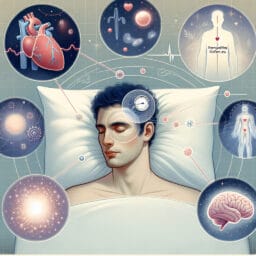
Understanding the Intricacies: Define Sleep Cycle
Table of Contents
- Understanding the Intricacies: Define Sleep Cycle
- The Five Stages of Sleep Cycle
- Factors Affecting Sleep Cycle
- Conclusion: The Importance of Sleep Cycle and Tips for Maintenance
- Frequently Asked Questions
Understanding the Intricacies: Define Sleep Cycle
A healthy sleep cycle is the linchpin of good health, playing a pivotal role in everything from boosting your immune system to maintaining heart rate. The intricacies of this process begin when you fall asleep, entering the lightest stage of non-REM sleep. As you drift further into slumber, you shift into deeper NREM stages before reaching the REM sleep stage where dreaming often occurs. This cyclical pattern repeats several times throughout the night with an increased percentage of REM sleep closer to morning. However, factors like age significantly affect this rhythm – a disruption that can lead to sleep-related issues and even increase your risk for neurological disorders. Sleep hygiene practices such as establishing regular bedtimes and avoiding certain medications can bolster quality sleep and promote optimal functioning during waking hours. Acknowledging these nuances underscores why understanding your sleep cycles is indispensable for staying asleep and securing restorative rest each night.
The Five Stages of Sleep Cycle
Appreciating the vital role sleep plays in maintaining good health is crucial. Amid life’s rigors, our bodies undergo a recurring sequence of sleep cycles that uphold an important function; it nourishes us for optimal functioning during the day. Each cycle comprises five distinct stages, ingeniously choreographed by our brain waves to transition us from wakefulness to deep sleep and then REM sleep. Beginning with lightest stage of non-REM (NREM) sleep as we fall asleep, our breathing slows down and heart rate decreases. As we slip into stage two, referred to as ‘sleep spindles’, our body temperature drops further preparing us for deep slumber.
Delta waves characterize the next two NREM stages ushering in deep sleep where tissue growth and repair occur, contributing significantly to improved immune system function. It is also during these deeper NREM stages that children grow and some hormones regulating appetite are released —underscoring how age affects this intricate process. The final act is staged by Rapid Eye Movement (REM) sleep which occupies about 25% of total sleep time in adults. This REM stage often hosts intense dreams due to heightened brain activity akin to being awake—an intriguing dichotomy where you’re asleep yet your mind seems astir.
Each of these well-orchestrated stages have unique restorative functions ensuring quality sleep—one often overlooked aspect is their impact on memory consolidation where information retention improves with each completed cycle comprising both NREM and REM phases. This harmonious rhythm between various states can be derailed by several factors such as irregular bedtimes or intake of certain medications—disrupting not just your circadian rhythm but also leading to negative outcomes like higher risk for neurological disorders or even more prevalent conditions like Sleep Apnea—a common yet serious disorder where breathing repeatedly stops during one’s slumber.
Thus, adopting good “sleep hygiene”—a lifestyle favoring habits promoting healthy sleep—is essential; it aids staying asleep thereby ensuring the necessary cycles for body repair and rejuvenation are completed. As we increasingly understand how our sleep stages form a symphony, playing out each night to restore us physically and mentally—it collectively reinforces what experts have long known: sleep is not just important, it’s essential. While we may still be unravelling the mysteries of why we dream or how exactly the brain processes information during various stages—an undisputed truth remains—our sleep cycles hold key to good health and well-being.
| Stage | Description | Impact on Health |
|---|---|---|
| Stage 1: Lightest stage of non-REM (NREM) sleep | Our breathing slows down and heart rate decreases as we fall asleep. | Initial preparation for deeper sleep stages. |
| Stage 2: Sleep Spindles | Our body temperature drops further, preparing us for deep slumber. | Preparation for deeper sleep stages, contributing to the overall restorative process of sleep. |
| Stage 3 & 4: Deep Sleep (NREM) | Characterized by delta waves, tissue growth and repair occur, contributing significantly to improved immune system function. Children grow and some hormones regulating appetite are released during these stages. | Crucial for immune system function, growth, hormone regulation, and overall health. |
| Stage 5: Rapid Eye Movement (REM) sleep | Often hosts intense dreams due to heightened brain activity akin to being awake. Occupies about 25% of total sleep time in adults. | Key for memory consolidation, information retention, and mental restoration. |
Factors Affecting Sleep Cycle
Did you know that the quality of your sleep is largely determined by how well you cycle through different stages of sleep? A healthy sleep journey ebbs and flows between light sleep, deep sleep, and REM (Rapid Eye Movement) cycles. The progression from light to deep non-REM sleep prepares your body for the REM stage – a vital phase for memory consolidation and mental restoration. However, factors such as age, lifestyle habits, and certain health conditions can significantly affect this natural rhythm.
Poor “sleep hygiene” practices like irregular bedtimes or heavy reliance on sleep medications can disrupt these delicate cycles. The result is often fragmented sleep where one struggles to stay asleep leading to a decreased total sleep time and poor overall quality of rest. Over time, failing to achieve the deeper stages of NREM or REM cycles can have a negative impact on both physical health – with potential heart rate abnormalities and a compromised immune system; and mental health causing cognitive impairment, mood swings among others.
Long-term disruptions in your circadian rhythm might also increase risk for serious neurological disorders or common but severe conditions like Sleep Apnea which entails repeated cessation in breathing during slumber – indeed proving how critical maintaining healthy cycles are.
Ageing adds another layer of complexity; it alters the proportion spent in each stage including slow-wave (deep) sleep generally seeing a decline thereby affecting one’s restorative functions linked with tissue repair growth hormones even appetite regulation.
Thus understanding how various elements shape our individual journey into the land of dreams helps shed light on their pivotal role towards good health vitality. It reinforces why ample importance should be attached not just to quantity but also the quality of our slumber ensuring we secure restful nights waking up refreshed ready for day ahead – because every hour dedicated to quality ZZZs counts!
Conclusion: The Importance of Sleep Cycle and Tips for Maintenance
As we journey into the realm of slumber, every twist and turn in our sleep cycle plays a pivotal role in maintaining good health. A harmonious symphony orchestrated by the brain, this rhythm of transitions between Non-REM (NREM) and REM stages is the cornerstone of restorative sleep. Essentially, our bodies tread through light sleep stages before sinking into deep NREM stages – a haven for tissue repair fueled by growth hormones and immune system fortification. Then comes the REM stage – a paradoxical phase where you’re asleep yet your brain waves mimic wakefulness; it’s an integral part of memory consolidation and mental rejuvenation.
However, various factors can disrupt this delicate ebb and flow. Age affects sleep cycles significantly – altering time spent in each stage including slow-wave or deep sleep which subsequently impacts restorative functions. Poor “sleep hygiene” practices like irregular bedtimes or over-reliance on sleep medications fracture these cycles leading to fragmented slumber that makes staying asleep harder – diminishing total sleep time and quality.
Long term disturbances can pose higher risk for severe conditions like Sleep Apnea or increase susceptibility to neurological disorders – underscoring why understanding our individual slumber patterns is critical to safeguarding our wellbeing. To ensure optimal heart rate maintenance during snooze hours, maintain regular sleeping hours, limit intake of certain medications that affect your nocturnal rhythm, focus on promoting quality over quantity while sleeping – because true wellness lies not just in falling asleep but staying ensconced in its folds long enough for essential body repairs to unfold.


